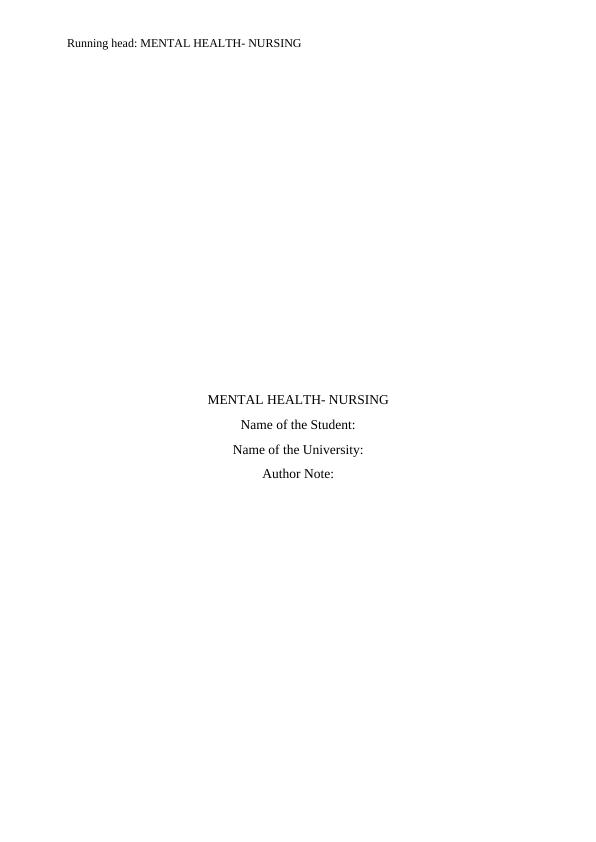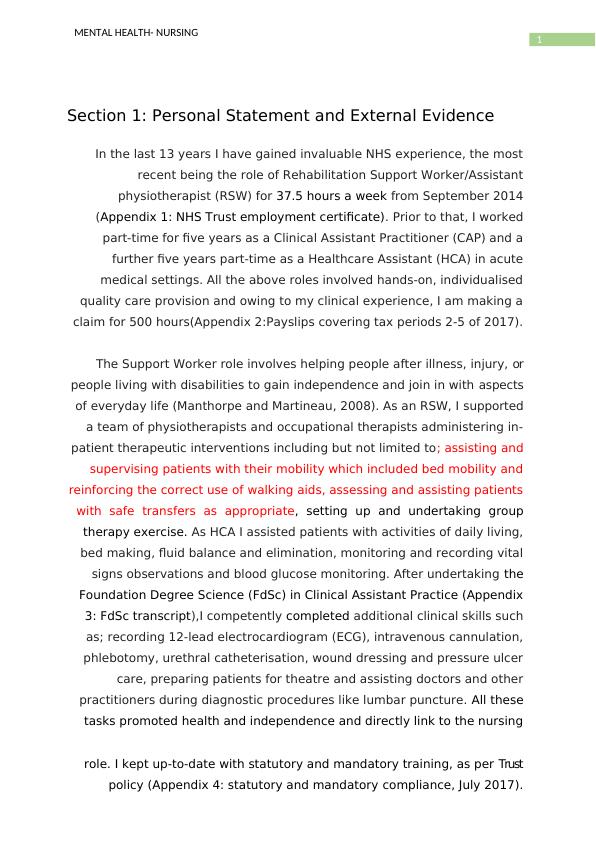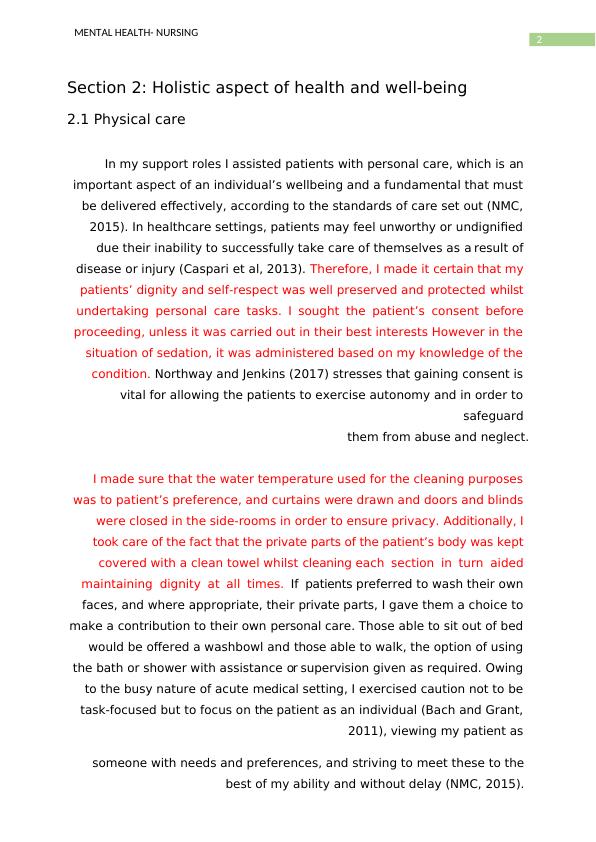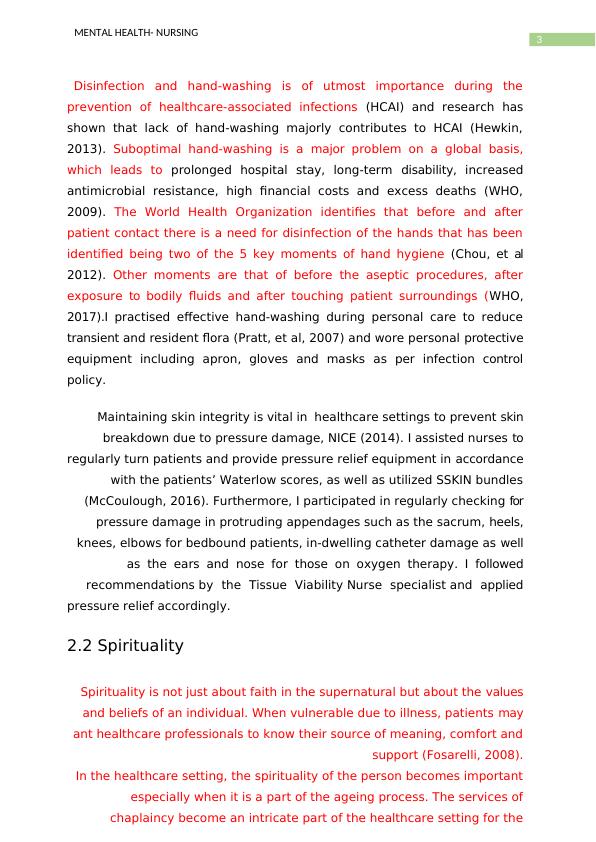Mental Health Nursing: Personal Statement and External Evidence
11 Pages3660 Words294 Views
Added on 2023-06-05
About This Document
This article discusses the personal statement and external evidence of a mental health nursing professional. It covers aspects of physical care, spirituality, psychological aspects, and social aspects. The article also includes relevant appendices and references.
Mental Health Nursing: Personal Statement and External Evidence
Added on 2023-06-05
ShareRelated Documents
Running head: MENTAL HEALTH- NURSING
MENTAL HEALTH- NURSING
Name of the Student:
Name of the University:
Author Note:
MENTAL HEALTH- NURSING
Name of the Student:
Name of the University:
Author Note:

1
MENTAL HEALTH- NURSING
Section 1: Personal Statement and External Evidence
In the last 13 years I have gained invaluable NHS experience, the most
recent being the role of Rehabilitation Support Worker/Assistant
physiotherapist (RSW) for 37.5 hours a week from September 2014
(Appendix 1: NHS Trust employment certificate). Prior to that, I worked
part-time for five years as a Clinical Assistant Practitioner (CAP) and a
further five years part-time as a Healthcare Assistant (HCA) in acute
medical settings. All the above roles involved hands-on, individualised
quality care provision and owing to my clinical experience, I am making a
claim for 500 hours(Appendix 2:Payslips covering tax periods 2-5 of 2017).
The Support Worker role involves helping people after illness, injury, or
people living with disabilities to gain independence and join in with aspects
of everyday life (Manthorpe and Martineau, 2008). As an RSW, I supported
a team of physiotherapists and occupational therapists administering in-
patient therapeutic interventions including but not limited to; assisting and
supervising patients with their mobility which included bed mobility and
reinforcing the correct use of walking aids, assessing and assisting patients
with safe transfers as appropriate, setting up and undertaking group
therapy exercise. As HCA I assisted patients with activities of daily living,
bed making, fluid balance and elimination, monitoring and recording vital
signs observations and blood glucose monitoring. After undertaking the
Foundation Degree Science (FdSc) in Clinical Assistant Practice (Appendix
3: FdSc transcript),I competently completed additional clinical skills such
as; recording 12-lead electrocardiogram (ECG), intravenous cannulation,
phlebotomy, urethral catheterisation, wound dressing and pressure ulcer
care, preparing patients for theatre and assisting doctors and other
practitioners during diagnostic procedures like lumbar puncture. All these
tasks promoted health and independence and directly link to the nursing
role. I kept up-to-date with statutory and mandatory training, as per Trust
policy (Appendix 4: statutory and mandatory compliance, July 2017).
MENTAL HEALTH- NURSING
Section 1: Personal Statement and External Evidence
In the last 13 years I have gained invaluable NHS experience, the most
recent being the role of Rehabilitation Support Worker/Assistant
physiotherapist (RSW) for 37.5 hours a week from September 2014
(Appendix 1: NHS Trust employment certificate). Prior to that, I worked
part-time for five years as a Clinical Assistant Practitioner (CAP) and a
further five years part-time as a Healthcare Assistant (HCA) in acute
medical settings. All the above roles involved hands-on, individualised
quality care provision and owing to my clinical experience, I am making a
claim for 500 hours(Appendix 2:Payslips covering tax periods 2-5 of 2017).
The Support Worker role involves helping people after illness, injury, or
people living with disabilities to gain independence and join in with aspects
of everyday life (Manthorpe and Martineau, 2008). As an RSW, I supported
a team of physiotherapists and occupational therapists administering in-
patient therapeutic interventions including but not limited to; assisting and
supervising patients with their mobility which included bed mobility and
reinforcing the correct use of walking aids, assessing and assisting patients
with safe transfers as appropriate, setting up and undertaking group
therapy exercise. As HCA I assisted patients with activities of daily living,
bed making, fluid balance and elimination, monitoring and recording vital
signs observations and blood glucose monitoring. After undertaking the
Foundation Degree Science (FdSc) in Clinical Assistant Practice (Appendix
3: FdSc transcript),I competently completed additional clinical skills such
as; recording 12-lead electrocardiogram (ECG), intravenous cannulation,
phlebotomy, urethral catheterisation, wound dressing and pressure ulcer
care, preparing patients for theatre and assisting doctors and other
practitioners during diagnostic procedures like lumbar puncture. All these
tasks promoted health and independence and directly link to the nursing
role. I kept up-to-date with statutory and mandatory training, as per Trust
policy (Appendix 4: statutory and mandatory compliance, July 2017).

2
MENTAL HEALTH- NURSING
Section 2: Holistic aspect of health and well-being
2.1 Physical care
In my support roles I assisted patients with personal care, which is an
important aspect of an individual’s wellbeing and a fundamental that must
be delivered effectively, according to the standards of care set out (NMC,
2015). In healthcare settings, patients may feel unworthy or undignified
due their inability to successfully take care of themselves as a result of
disease or injury (Caspari et al, 2013). Therefore, I made it certain that my
patients’ dignity and self-respect was well preserved and protected whilst
undertaking personal care tasks. I sought the patient’s consent before
proceeding, unless it was carried out in their best interests However in the
situation of sedation, it was administered based on my knowledge of the
condition. Northway and Jenkins (2017) stresses that gaining consent is
vital for allowing the patients to exercise autonomy and in order to
safeguard
them from abuse and neglect.
I made sure that the water temperature used for the cleaning purposes
was to patient’s preference, and curtains were drawn and doors and blinds
were closed in the side-rooms in order to ensure privacy. Additionally, I
took care of the fact that the private parts of the patient’s body was kept
covered with a clean towel whilst cleaning each section in turn aided
maintaining dignity at all times. If patients preferred to wash their own
faces, and where appropriate, their private parts, I gave them a choice to
make a contribution to their own personal care. Those able to sit out of bed
would be offered a washbowl and those able to walk, the option of using
the bath or shower with assistance or supervision given as required. Owing
to the busy nature of acute medical setting, I exercised caution not to be
task-focused but to focus on the patient as an individual (Bach and Grant,
2011), viewing my patient as
someone with needs and preferences, and striving to meet these to the
best of my ability and without delay (NMC, 2015).
MENTAL HEALTH- NURSING
Section 2: Holistic aspect of health and well-being
2.1 Physical care
In my support roles I assisted patients with personal care, which is an
important aspect of an individual’s wellbeing and a fundamental that must
be delivered effectively, according to the standards of care set out (NMC,
2015). In healthcare settings, patients may feel unworthy or undignified
due their inability to successfully take care of themselves as a result of
disease or injury (Caspari et al, 2013). Therefore, I made it certain that my
patients’ dignity and self-respect was well preserved and protected whilst
undertaking personal care tasks. I sought the patient’s consent before
proceeding, unless it was carried out in their best interests However in the
situation of sedation, it was administered based on my knowledge of the
condition. Northway and Jenkins (2017) stresses that gaining consent is
vital for allowing the patients to exercise autonomy and in order to
safeguard
them from abuse and neglect.
I made sure that the water temperature used for the cleaning purposes
was to patient’s preference, and curtains were drawn and doors and blinds
were closed in the side-rooms in order to ensure privacy. Additionally, I
took care of the fact that the private parts of the patient’s body was kept
covered with a clean towel whilst cleaning each section in turn aided
maintaining dignity at all times. If patients preferred to wash their own
faces, and where appropriate, their private parts, I gave them a choice to
make a contribution to their own personal care. Those able to sit out of bed
would be offered a washbowl and those able to walk, the option of using
the bath or shower with assistance or supervision given as required. Owing
to the busy nature of acute medical setting, I exercised caution not to be
task-focused but to focus on the patient as an individual (Bach and Grant,
2011), viewing my patient as
someone with needs and preferences, and striving to meet these to the
best of my ability and without delay (NMC, 2015).

3
MENTAL HEALTH- NURSING
Disinfection and hand-washing is of utmost importance during the
prevention of healthcare-associated infections (HCAI) and research has
shown that lack of hand-washing majorly contributes to HCAI (Hewkin,
2013). Suboptimal hand-washing is a major problem on a global basis,
which leads to prolonged hospital stay, long-term disability, increased
antimicrobial resistance, high financial costs and excess deaths (WHO,
2009). The World Health Organization identifies that before and after
patient contact there is a need for disinfection of the hands that has been
identified being two of the 5 key moments of hand hygiene (Chou, et al
2012). Other moments are that of before the aseptic procedures, after
exposure to bodily fluids and after touching patient surroundings (WHO,
2017).I practised effective hand-washing during personal care to reduce
transient and resident flora (Pratt, et al, 2007) and wore personal protective
equipment including apron, gloves and masks as per infection control
policy.
Maintaining skin integrity is vital in healthcare settings to prevent skin
breakdown due to pressure damage, NICE (2014). I assisted nurses to
regularly turn patients and provide pressure relief equipment in accordance
with the patients’ Waterlow scores, as well as utilized SSKIN bundles
(McCoulough, 2016). Furthermore, I participated in regularly checking for
pressure damage in protruding appendages such as the sacrum, heels,
knees, elbows for bedbound patients, in-dwelling catheter damage as well
as the ears and nose for those on oxygen therapy. I followed
recommendations by the Tissue Viability Nurse specialist and applied
pressure relief accordingly.
2.2 Spirituality
Spirituality is not just about faith in the supernatural but about the values
and beliefs of an individual. When vulnerable due to illness, patients may
ant healthcare professionals to know their source of meaning, comfort and
support (Fosarelli, 2008).
In the healthcare setting, the spirituality of the person becomes important
especially when it is a part of the ageing process. The services of
chaplaincy become an intricate part of the healthcare setting for the
MENTAL HEALTH- NURSING
Disinfection and hand-washing is of utmost importance during the
prevention of healthcare-associated infections (HCAI) and research has
shown that lack of hand-washing majorly contributes to HCAI (Hewkin,
2013). Suboptimal hand-washing is a major problem on a global basis,
which leads to prolonged hospital stay, long-term disability, increased
antimicrobial resistance, high financial costs and excess deaths (WHO,
2009). The World Health Organization identifies that before and after
patient contact there is a need for disinfection of the hands that has been
identified being two of the 5 key moments of hand hygiene (Chou, et al
2012). Other moments are that of before the aseptic procedures, after
exposure to bodily fluids and after touching patient surroundings (WHO,
2017).I practised effective hand-washing during personal care to reduce
transient and resident flora (Pratt, et al, 2007) and wore personal protective
equipment including apron, gloves and masks as per infection control
policy.
Maintaining skin integrity is vital in healthcare settings to prevent skin
breakdown due to pressure damage, NICE (2014). I assisted nurses to
regularly turn patients and provide pressure relief equipment in accordance
with the patients’ Waterlow scores, as well as utilized SSKIN bundles
(McCoulough, 2016). Furthermore, I participated in regularly checking for
pressure damage in protruding appendages such as the sacrum, heels,
knees, elbows for bedbound patients, in-dwelling catheter damage as well
as the ears and nose for those on oxygen therapy. I followed
recommendations by the Tissue Viability Nurse specialist and applied
pressure relief accordingly.
2.2 Spirituality
Spirituality is not just about faith in the supernatural but about the values
and beliefs of an individual. When vulnerable due to illness, patients may
ant healthcare professionals to know their source of meaning, comfort and
support (Fosarelli, 2008).
In the healthcare setting, the spirituality of the person becomes important
especially when it is a part of the ageing process. The services of
chaplaincy become an intricate part of the healthcare setting for the

End of preview
Want to access all the pages? Upload your documents or become a member.
Related Documents
Ethical Dilemma Faced by a Nursing Student in Providing Care to a Mentally Ill Patientlg...
|8
|1919
|213
Nursing Reflection: Episode of Patient Carelg...
|12
|3166
|305
Role of Advance Nurse Practitionerslg...
|9
|3382
|272
HLT54115 Diploma of Nursinglg...
|26
|9855
|27
Professional Accountabilitylg...
|9
|2003
|32
Patient Experience and Partnering in Carelg...
|9
|2343
|207
